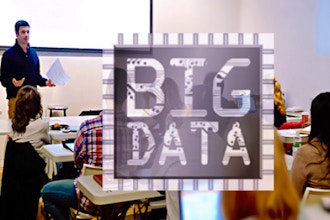 Sell tickets and manage registrations
Sell tickets and manage registrations
 View my tickets and registrations
View my tickets and registrations
 Sell more tickets through digital marketing
Sell more tickets through digital marketing
 Add an event calendar to your website
Add an event calendar to your website
 Find events by location and categories
Find events by location and categories
Data Analytics

This is a 10-week part-time or 1-week accelerated course.
The Big Picture
: Confidently make—and defend—critical decisions using the results of your data analysis.
Skills, Tools, & Strategies
: Use Excel, SQL, and Tableau to spot trends and drive business decisions with real-world data.
Analytics in Practice
: Share your insights and tell compelling stories using data visualizations and dashboards.
Unit 1: Exploring Data with Excel
Understanding the Value of Data
Explore the value of data.
Work your way through the data analytics workflow.
Unlock the power of Microsoft Excel to utilize its analytical tools — no matter your experience level.
Practice applying the data analytics workflow to a sample business case.
Preparing Data in Excel
Discuss data cleaning best practices.
Review strategies to prepare and clean a data set.
Practice asking the “right” questions of our data.
Referencing Data in Excel
Use named ranges to easily reference data subsets.
Use the VLOOKUP and HLOOKUP functions to manipulate data sets.
Look up values in other tables using the functions INDEX and MATCH.
Aggregating Data in Excel
Summarize data using pivot tables.
Execute Excel aggregation commands (SUM, AVERAGE, COUNT, etc.) and their conditional variants (COUNTIF, COUNTBLANKS, etc.) to summarize data sets.
Explore data using conditional formatting for categorization and analysis.
Visualizing Data in Excel
Use scatter plots, bar graphs, and histograms to visualize data.
Explore color theory and how it applies to data visualization.
Build your own data dashboard using industry best practices.
Apply visual design principles to your dashboard to present your findings clearly.
Applying Statistics for Data Analysis
Understand the value of descriptive and inferential statistics.
Learn to describe data and identify outliers using its mean, median, mode, range, and variance.
Practice applying statistical functions in Excel.
Building Data Narratives
Learn best practices for describing analysis techniques.
Communicate insights and implications for stakeholders.
Deliver short, effective presentations sharing your findings.
Provide context for your audience by identifying and presenting the salient statistics.
Unit 2: Managing Data with SQL
Foundations of Databases and SQL
Learn about data structures and the role of structured query language (SQL).
Filter data using advanced SQL commands (Where, Group By, Having, Order By, Limit).
Obtain data by creating relationships between tables using Joins.
Gather filtered data using SQL Boolean operators (AND and OR) and SQL conditional operators (=,!=,>,<,IN, and BETWEEN).
Aggregating Data in SQL
Create relationships between tables and data points (including has_many and many_to_many) using Join tables and multiple Joins.
Write Boolean statements with SQL conditional operators (=, !=, >, <, IN, and BETWEEN).
Summarize data sets by employing aggregation commands (“Sum,” “Average,” “Count,” etc.).
Determine data trends by applying aggregation methods.
Using Logic and Functions in SQL
Explain the differences between NULL and zero.
Use SQL NULL to create Boolean functions and handle zeros.
Apply string functions to manipulate how data is presented.
Apply math functions to add value to the data you are working with.
Apply date logic to your SQL queries.
Writing Efficient, Dynamic Queries and Subqueries
Use CASE statements to structure data and create new attributes.
Combine multiple subqueries into one using “WITH AS.”
Optimize queries using WHERE, LIMIT, and COALESCE.
Unit 3: Communicating Data Analysis with Tableau
Exploring the Fundamentals of Tableau
Get hands-on, practical experience navigating the Tableau software interface.
Connect your data to Tableau and identify the best ways to visualize and display your results.
Visualizing Data and Text Manipulation in Tableau
Use bubble graphs and a variety of visualizations to identify and communicate data insights.
Create a number of calculated fields to clean and manipulate strings of text using LEFT, MID, FIND, and REPLACE.
Text and Sentiment Analysis in Tableau
Use the Twitter web data connector to bring tweet data into Tableau.
Analyze and visualize your data pull in Tableau in order to answer basic questions.
Designing Data Dashboards in Tableau
Contextualize analysis results by creating Tableau dashboards.
Incorporate charts and conditional formatting into your dashboard using supporting information specific to a particular data set.
Working with Data Across Excel, SQL, and Tableau
Understand the use of specific data analysis software.
Apply all the tools and skills you’ve acquired in Excel, SQL, and Tableau to analyze a data set from start to finish.
Final Project Presentations
Identify strengths and areas for improvement in your analytical skills with feedback from peers, instructors, and guest panelists.

